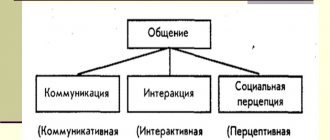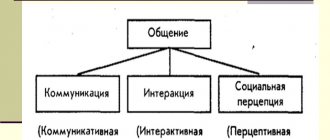Communication always presupposes a certain result; it leads to a change in the behavior or type of activity of people. The interactive side of communication is a conventional concept that characterizes the components of the interaction process and gives them certain functions. During joint activities, not only information is exchanged, but also common goals are realized. Interacting and communicating with each other, people talk and perform actions.
Meaning and functions of communication
The interactive function of communication is aimed at developing strategies and tactics in the relationships and interactions of people. This type of communication involves the involvement of all participants in a joint process. Psychologists look at it from different sides. Stages that participants go through:
- Spatial.
- Psychological.
- Social.
- Interactions.
- Relationship.
Initially, people find themselves in the same space, get used to each other, begin to actively exchange information, and determine common goals and motives. Then they are involved in the active process of implementing the plan. At the end of joint actions, a certain model of relationships is built. People continue to keep in touch and communicate or scatter in different directions.
Interactive communication is necessary for building relationships with society, helping a person to realize himself as an individual. Its function is to establish contacts and build a model of joint action. It is used not only in the business sphere, but also in everyday communication with loved ones and family members.
Manifestation of the interactive aspect of communication
The perceptual side of communication in psychology
Finding a person in any social group requires interaction; it cannot be one-sided. Therefore, psychologists consider interaction as an aspect based on a variety of connections.
Areas of communication
| Type of communication | Peculiarities |
| Labor sphere | The most common option, which includes conversations between team members, discussion of joint plans for the implementation of work activities, real-time communication via the Internet and mobile communications |
| Education | Visiting school and other educational institutions is another option for communication. Here you can add distance learning conducted in real time |
| Family relationships | The closest contact of communication, based on the distribution of responsibilities for solving everyday and personal problems (household management, giving birth and raising children, caring for the elderly, etc.) |
| Leisure | People spend their free time not only with their families, but also with friends. Go to theaters, restaurants and participate in festive events |
Relaxation with friends
The actions of each individual are focused on the object of communication and depend on it. Therefore, 2 options are being considered:
- productive;
- unproductive.
In the 2nd case, the interaction can be interrupted by itself or on the initiative of one of the participants in the communication.
Important! For joint activities to become productive, there must be compatibility between the subjects. It does not matter at what level the communication is.
The closer the interaction between people, the more multi-tiered it becomes. This can be considered using the example of a married couple. The following compatibility aspects are covered here:
- physiological, including the gender and age characteristics of family members, metabolic processes occurring in a small unit of society, the tempo-rhythmic organization of life, the nervous system of subjects;
- psychophysiological means the temperaments of individuals, personal needs and the family as a whole;
- psychological, manifested in the interaction of motives of behavior and characters;
- socio-psychological phenomenon - orientation towards certain values, coordination of interests, distribution of roles.
The main focus is on psychological compatibility. It is important for people to be able to make contact and be tolerant of the individual characteristics and needs of the participants in communication.
Interaction Structure
Social psychology tried to explain and describe the structure of human interactions and the interactive side of communication in general. The process and essence of communication is not complicated.
Participants in communication are characterized by:
- common goal;
- joint motives;
- single space;
- coordination of actions;
- knowledge of generally accepted rules;
- transfer of information.
In other words, this is not just a conversation about nothing, but a targeted exchange of information to achieve a specific result. In the process of communication, the participants agree on how they will act, what each of them will do. Provides:
- analysis of partners’ plans and their comparison with one’s own aspirations;
- assessing the contribution of participants during interaction;
- understanding the return of partners.
Interaction in interpersonal relationships plays an important role. Without interaction, it is impossible to coordinate actions and achieve the desired results.
READ What to talk about with a girl on the phone: interesting topics for conversation
The organization of interactions takes place in accordance with the norms, and each participant chooses ways to implement their plans in accordance with their own principles. Motivation is to satisfy needs. In the process of joint activity, several types of contacts occur: spatial, psychological, social.
The participant chooses a certain strategic position:
- "Child". Desires and actions are motivated by the desire “I want.”
- "Parent". Meets the “must” position.
- "Adult". Combines the two previous positions.
Interaction and further interaction are possible if interests coincide. Otherwise, the contact will be destroyed and the desired goal will not be achieved.
Relationship Example
A wife talks to her husband about a broken food processor like a proper adult. Husband's answers from different positions:
- Adult: “I’ll take a look and take it to the master if everything is bad.”
- Parent: “There’s always something going on with you.”
- Child: “What should I do now?”
Participants must have adequate understanding and acceptance of the situation.
There is no clear structure of the interactive communication function. Experts consider the components of communication from different angles, giving their classification.
Main types
Conventionally, interactive communication is divided into 2 types:
- Cooperation. It is a joint activity of people, as a result of which all actions are synchronized and cooperated. Participants act as one team, each contributing to the common cause. As they say, they communicate on the same wavelength. Cooperation involves the division of responsibilities between partners in order to achieve a common goal.
- Competition. Participants' opposition. The basis of such interactions is conflict, forcing a person to act, prove, achieve. Conflict involves the presence of opposing opinions and tendencies. In such a relationship, there is only one outcome - resolving the conflict and achieving the desired goals.
The division into types is conditional, since conflict also arises during cooperative actions. At the same time, competition can develop into fruitful cooperation.
Psychologists also distinguish several types of interaction:
- With the simultaneous involvement of all participants in the process. Sport Team.
- Sequential execution of tasks using a conveyor type.
- Division of functions between participants, while each retains its individuality and has freedom of action. This may include working in a corporation or commercial company.
Interaction refers to the active interaction of all participants and the use of one or another model of behavior.
Areas of application
Business communication is present in different spheres of human life. Issues regarding joint actions are resolved at work, in the family, even during leisure time. Communication areas:
- Collective labor activity. Each employee performs duties and solves assigned tasks. As a result, all colleagues work for the benefit of the organization. Communicate with each other verbally, non-verbally, using digital and computer technologies.
- Education. The educational process is an inexhaustible flow of information with feedback. The person delivering the information must receive back the result of his labors. The interactive side of communication in the learning process involves the active use of computer technology, knowledge exchange, feedback, and the involvement of all participants in the process.
- Leisure. Organization of leisure and recreation involves business cooperation and distribution of responsibilities. If everyone acts as they please, the event will fail. Modern leisure involves the involvement of specialists (presenters, musicians). This is already an obvious business cooperation.
READ Ethics of business communication: principles of successful business
In everyday life, no family can do without interaction. Husband and wife perform their duties for the good of the family. Children contribute to the common cause.
General goals and results
Participants must have common goals and focus on results. As a result, information, behavior and actions are exchanged, and mutual influence is exercised. In the process of communication, experience is exchanged, personality is formed and improved, new aspirations and desires appear. The productive process is present in all spheres of human life, from study to leisure. With coordinated work, order is observed in society and its individual components. It is an integral part of social, public and personal life.
Compatibility Considerations
Long-term and fruitful communication is possible only when the interests of the goals coincide. When there is nothing in common, the tandem falls apart. An example is a personal relationship between lovers, when a girl plans to build a family, get married, and a guy wants to have a good time and relax. When participants realize that the goals are not aligned, the interaction ends.
Forms and examples
Typically there are three forms of interactive interaction :
- Positive (cooperation, agreement, adaptation, association). In the first case, it is expressed in the organization of joint activities aimed at achieving the desired result for all participants in the process. In cooperation, a number of people unite into a common group to achieve a common goal. Consent means that a person expresses his approval of the majority position, without necessarily participating in activism himself. Adaptation implies that a person adjusts to the given circumstances. Association - the presence of a close connection between participants in the process who are similar to each other.
- Adversarial (competition, rivalry). This is where the competitive aspect comes first.
In competition, there is a clash of interests of subjects who simultaneously claim the same benefits or achievements. Moreover, such a social process is both positive and negative.On the one hand, participants in the competition try to make every effort, improve their skills, and develop effective strategies. On the other hand, they are in a constant state of emotional tension and may resort to forbidden techniques in order to get what they want. Rivalry implies the manifestation of a desire to prevail over an opponent of equal strength. It can manifest itself openly or covertly. Rivals are in a state of active struggle for power, prestige, realization, recognition, etc. They realize that one will be a winner and the other will be a loser, which encourages them to defend their own interests.
- Negative (conflict, opposition, dissociation). What is? During joint activities, serious obstacles to effective interaction arise.
Conflict is the most negative type of interactive interaction, in which serious disagreements and disputes arise between participants.Opposition is a manifestation of a negative reaction to a proposed action, behavior pattern or strategy. Dissociation is a mental process in which a person protects himself from an unpleasant situation by withdrawing from it. He imagines that everything that happens has to do with someone else, and not with him.
Positive interaction is observed during any effective joint activity. This could be the learning process, working on projects, holding cultural events, spending time together and much more.
For example, a positive interaction can be called a situation when, during a cleanup day, the organization’s staff jointly cleans up the area in front of its building.
Another example is children’s joint efforts to clean the apartment before their mother’s arrival.
The adversarial form of interaction is typical for business and professional activities.
This is where the clash of key interests of people who strive to achieve career success, realize their ambitions, and ensure their material well-being occurs.
Employees occupying the same position in the company may compete with each other during the implementation of projects, since everyone will strive to attract the attention of their superiors.
Negative interaction causes significant damage to the emotional state of its participants and reduces the effectiveness of their joint activities.
Parties that are in a state of hostility to each other cannot join forces to achieve a goal .
Thus, a conflict between spouses that arises when choosing new furniture for an apartment will lead to loss of time, irritation on both sides, and reluctance to make efforts to find a compromise.
Other aspects of the relationship
Interactive communication is considered in combination with other communication functions and cannot be isolated.
Perceptual
The definition of perceptual function is related to a person's perception of information or situation. This is an understanding of yourself and your partners. In the process of communication, psychological processes operate that make it possible to adequately assess the behavior and individual characteristics of people.
In the course of perceptual communication, identification, reflection, and empathy are formed:
- Identification means identifying oneself with a partner and becoming like him. The result is understanding and acceptance of the interlocutor’s motives, as well as adaptation to a common goal.
- Empathy is the emotional experience of a situation and acceptance of another person’s behavior. Based on a psychological assessment, sympathy or antipathy is formed. Further communication will continue according to the scenario of either cooperation or conflict.
- Reflection encourages the participant to act reflexively based on personal needs.
The perceptual function helps to build interaction.
Communicative
It involves the exchange of information. In the process of communication, participants exchange opinions, experiences, knowledge, interests, feelings and moods. Any conversation carries certain information and activates cognitive function. In interaction, information flow is the basis of long-term interactions and relationships.
Regulatory
Involves changing behavior under the influence of other people. The regulatory function controls and coordinates business communications. The interaction and behavior of participants is based on emotions:
- positive - solidarity, agreement, lack of tension;
- negative - conflict, disagreement, tension, demonstration of antagonism;
- problematic - a request to express an opinion, share information, the need for instructions, suggestions, instructions.
READ How to understand that a guy likes you at school: signs and behavioral characteristics
The regulatory function determines the nature of the interaction between participants. This can be an individual activity, sequential or simultaneous. In the process of mutual influence, the formation of persuasion, suggestion and imitation occurs.
Factors influencing the contact process
For interaction to be productive, certain circumstances are required. Basic prerequisites include:
- awareness of human needs (one’s own and those of participants in interaction);
- the ability to create motives, strengthen them, encouraging participants to take active action in the right direction;
- using various incentives to help increase motivation.
Factors supported by moral norms and universal rules will help avoid conflicts during the contact process and raise interactive communication to the maximum level.
Behavioral styles
Developed as a result of conflict. Their types:
- Evasion. The outcome of a conflict situation does not matter to a person or there is no strength or ability to solve the problem. He begins to ignore communication in every possible way, he has no desire to defend interests, prove he is right, or cooperate to achieve a common goal.
- Confrontation, competition. Active struggle of participants, defending positions, opinions, interests. Available methods are used to solve the problem to your advantage. Pressure or coercion is used. Participants strive to win by any means and methods.
- Compliance, adaptation. The actions of the participants are aimed at creating and maintaining a tandem, an idyll in relationships. There is a smoothing out of disagreements by infringing on one’s own interests. This model of behavior is used if it is not the situation that is important, but the preservation of the relationship.
- Cooperation. Participants find alternative options and convenient solutions. The needs and interests of partners are satisfied without compromising one’s own aspirations. This model of behavior is characterized by compromise, when any problem is solved through discussion and joint decision making.
Behavioral style is developed under the influence of external and internal factors. Depends on subjective and objective circumstances.
Factors and basic styles of behavior
Types of communication in psychology - what they include, its functions
Interaction will be effective if the subjects not only correctly understand the situation, but also express themselves adequately in it. Each person has his own manner of behavior, it affects self-presentation.
Interaction styles
| Name | Peculiarities |
| Ritual | Consists of greetings, polite questions, festive communication (anniversaries, weddings, corporate events, etc.). Style is set by generally accepted culture and is aimed at interaction in society |
| Manipulative | Consists in the desire to subjugate and control other subjects, treating them as a means to achieve a goal |
| Humanistic | It is based on trusting, honest relationships, tolerance towards others, awareness of oneself as an individual. |
In effective interaction, not only the style of behavior is important, but also the contribution of each participant to the common cause. Here we can distinguish 3 models of joint communication:
- individual activity, when the subject performs his part of the functions, regardless of how other members of the team cope with this;
- consistent, when people are involved in the pipeline; the general problem is solved in turn by each of the participants;
- interacting, in which the goal is achieved only by simultaneous joint efforts.
The ratio of individual contributions determines the form of interaction. In the interactive side of communication, this manifests itself in 2 types.
Main types of interaction
| Method of interaction | Description |
| Cooperation | Determined by the joint efforts of participants aimed at solving one problem. Responsibilities and functions are organically distributed among team members, which leads to fruitful cooperation. Cooperation is characterized by the following features of activity: • distribution of the process among all participants; • changing the actions of subjects if the activity does not satisfy personal needs. The best cooperation is one that is based on collaborative communication. |
| Competition | Expressed as a confrontation between participants. During confrontation, personal goals are important for the subject, which usually run counter to the goals of the partners. |
The most striking manifestation of competition is a conflict that undermines joint activities.
Conflict of interest
Types of behavior during conflicts
| Behavior option | Content |
| Evasion | The subject does not seek to defend his rights, does not express his own point of view, and avoids making responsible decisions. This is caused by the complexity of the task or the lack of its importance |
| Rivalry | Actively defending one’s own interests by any available means. A tough position towards dissenting participants in an interaction indicates the great importance of the situation for the subject |
| Device | Acting according to circumstances, the individual strives to establish and maintain favorable relationships for himself. Constant agreement with the point of view of the interlocutor hinders personal development |
| Cooperation | This option is characterized by the interest of all participants in the interaction and an open exchange of opinions. At the same time, the individual also takes into account his own interests. |
| Compromise | A brief definition of the term can be represented as interaction aimed at finding solutions that satisfy each participant |
The modern science of conflictology analyzes all situations and helps participants choose the most appropriate style of behavior using tests and trainings.
Ability to meet halfway
Effects of perception
The same information is perceived by people differently. Partners tend to distort information, resulting in the formation of the wrong opinion:
- Halo effect. The idea of an object is formed on the basis of a separate significant quality. It appears when the participant has insufficient information or evaluates moral qualities. Thus, a wrong impression about a person often arises at the first meeting. In the future, no matter what he does, his opinion does not change.
- Novelty. The bottom line is the tendency to trust new information. If you have recently received negative information about an object or person, the same opinion will remain.
- Contrast. Evaluating objects and people when compared with ideals.
- Projection. The interlocutor who evokes sympathy is credited with the best qualities and his own merits. With antipathy, the partner is assessed from the worst side.
Perception errors negatively affect the effectiveness of joint work and prevent an objective and adequate assessment of the situation.
Interaction is present in all spheres of human life, including when communicating on social networks. It is considered a modern method of information exchange.
The role of communication in human life.
Communication is a complex process of interaction between people, consisting of the exchange of information, as well as the perception and understanding of each other by partners.
The subjects of communication are living beings, people. In principle, communication is characteristic of any living beings, but only at the human level does the process of communication become conscious, connected by verbal and non-verbal acts. The person transmitting information is called a communicator, and the person receiving it is called a recipient. Communication is of great importance in the formation of the human psyche, its development and the formation of reasonable, cultural behavior. Through communication with psychologically developed people, thanks to ample opportunities for learning, a person acquires all his higher cognitive abilities and qualities. Through active communication with developed personalities, he himself turns into a personality. If from birth a person was deprived of the opportunity to communicate with people, he would never become a civilized, culturally and morally developed citizen, and would be doomed to remain a half-animal until the end of his life, only externally, anatomically and physiologically reminiscent of a person. There are numerous testimonies to this; facts described in the literature and showing that, being deprived of communication with his own kind, the human individual, even if he, as an organism, is completely preserved, nevertheless remains a biological being in his mental development. As an example, we can cite the conditions of people who are found from time to time among animals and who for a long period, especially in childhood, lived in isolation from civilized people or, already as adults, as a result of an accident found themselves alone, isolated for a long time from their own kind ( for example, after a shipwreck). Communication with adults in the early stages of ontogenesis is especially important for the mental development of a child. At this time, he acquires all his human, mental and behavioral qualities almost exclusively through communication, since until the start of school, and even more definitely before adolescence, he is deprived of the ability for self-education and self-education. The mental development of a child begins with communication. This is the first type of social activity that arises in ontogenesis and thanks to which the baby receives the information necessary for its individual development.
Perceptual side of communication
The perceptual side of communication is the understanding of the human interlocutor. The process occurs at all levels accessible and understandable to humans. While people communicate, each of them tries to understand, cognize and make one question clear to themselves: who is the person opposite?
To get to know another person, the following are analyzed:
- His external data to understand the meaning of his statements.
- His emotional state, attitude to the topic, what is happening.
- His view of how he connects objects, relates to them, interprets them.
- His beliefs, attitudes, worldview, etc.
- His system of thinking, train of thought.
At least two people must participate in the process. Each of them tries to get to know the second personality in order to give themselves an answer to the main question about who is in front of them. When a person understands another, then it is easier for him to decide what to say, how to react, what to advise, how to behave, etc. However, getting to know another person takes a lot of time. This is where the brain function of thinking comes into play.
Since each person has experience of past contacts with other people, he already has some ideas about them, has noted some similarities between personalities, he can use this knowledge to supplement the missing information. In other words, a person makes an assumption about who is in front of him based on the experience that he has. Because this happens automatically, people often notice that they are making mistakes. However, the first opinion always seems to be correct, since the person has already encountered something similar, which allows him to think that this time he has encountered the same thing.
The perceptual side of communication is aimed at understanding the other person. Why is this necessary? In order to further predict your behavior. Since communication does not occur without the desire to influence the interlocutor, change his beliefs, make him a like-minded person, a person must first understand how the interlocutor thinks and what is guided by him in order to use the information received for his own benefit.
This is not good or bad. It just happens automatically, since every person wants to understand those around him in order to choose a model of communication that will be beneficial to him.
go
Main literature
- Andreeva G.M.
Social psychology: a textbook for students. universities, educational in direction and special "Psychology". — Ed. 5th, rev. and additional - M.: Aspect Press, 2010; 2008.
- Andrienko E.V.
Social psychology: Textbook for students. higher ped. textbook institutions /Under the editorship of V.A. Slastenin. - M.: Academy, 2008.
- Bogomolova N. N.
Social psychology of mass communication: textbook. aid for students universities, educational according to special and direction "Psychology". - M.: Aspect-Press, 2010.
- Goryanina V.A.
Psychology of communication: textbook. aid for students fak. social.. - 4th ed., erased. - M.: Academy, 2007.
- Kovalchuk A.S.
Fundamentals of business communication: textbook. aid for students universities - M.: Dashkov and K, 2007.
- Krysko V.G.
Social psychology in diagrams and comments. - St. Petersburg, 2003.
- Krysko V.G.
Social psychology: Course of lectures. - 3rd ed. - M.: Omega, 2006.
- Leontyev A.A.
Psychology of communication: textbook. aid for students universities, educational according to special "Psychology". — Ed. 3rd. - M.: Meaning: Academy, 2005.
- Myers D. Social psychology. - St. Petersburg: Peter, 2003.
- Nemov R.S., Altunina I.R.
Social Psychology. - St. Petersburg: Peter, 2009.
- Pochebut L.G.
Cross-cultural and ethnic psychology: textbook. aid for students universities, educational in humanities specialist. - St. Petersburg: Peter, 2012.
- Rean A.A., Kolominsky Ya.L.
Social educational psychology. — 2nd ed., add. and processed - St. Petersburg, 2008.
- Social psycholinguistics:
reader / comp. K. F. Sedov. - M.: Labyrinth, 2007.
- Social Psychology
: Textbook. manual for university students / Ed. A.N. Sukhov, A.A. Derkach. - M.: Academy, 2007.
- Social Psychology
: Reader: Textbook. manual for university students / Comp. E.P.Belinskaya, O.A.Tikhomandritskaya. - M.: Aspect Press, 2003.
Communicative
Most often, when people talk about communication, they mean precisely its communicative side.
In this case, we are talking about the exchange of information between subjects of social relations.
People share their thoughts, plans, ideas, views with each other. Based on the information received, relationships are built and activities are organized.
Communication should be viewed as more than just an endless flow and reception of information. All parties to the process take an active position and strive to understand the information provided to them.
The quality of contact is determined by the level of perception of information, its acceptance and understanding.
If one subject constantly puts forward his ideas and views, and the second does not perceive or even understand them, then there is no need to talk about effective communication in this case.
The communication side is a way of psychologically influencing an opponent. During the transfer of information, one person influences another. The more developed a subject’s communication skills are, the higher the level of influence he has on his interlocutors.
Successful speakers, political and ideological leaders are, first of all, people with excellent communication skills.
The ability to influence others through speech allows such individuals to gain a certain position in society.
Information is provided on two levels:
- Incentive. These are remarks of an ordering, pleading, recommendatory nature. They are expressed with the aim of stimulating a person to perform some action.
- Stater. This is a notification speech, which is aimed at providing some information. Ranges from indifferent presentation to active persuasion.
It should be taken into account that even among representatives of the same language group, misunderstandings may arise during the exchange of information. That is, the same information is evaluated differently.
This is explained by the influence of a number of factors: age, social status, intellectual abilities, emotional mood, etc.
Thus, a child and an adult perceive the same news at completely different levels due to age-related characteristics of the psyche and intellect.
Communications occur at the interpersonal level (between spouses, friends, colleagues, relatives), and at the group level. For example, during breakfast on a weekend, a husband and wife exchange ideas for leisure activities.
One participant in the contact expresses his thoughts and ideas, and the second listens to him.
Periodically they change roles.
As a result, effective interaction is built, each participant of which has the opportunity not only to express his opinion, but also to obtain the necessary information from his opponent.
An example of group communication is a teacher teaching a lesson in a classroom. During the lesson, the teacher who has the information shares it with his students.
At the same time, children have the opportunity not only to perceive incoming information, but also to ask clarifying questions and express their thoughts. This communication is effective and efficient.
At the same time, another teacher may provide children with information from a perspective that is completely incomprehensible to them. At the same time, students do not have the opportunity to ask questions, express their opinions, or clarify the information received.
In such a situation, the flow of information passes by the subjects to whom it was directed. The communication process turns out to be ineffective.











